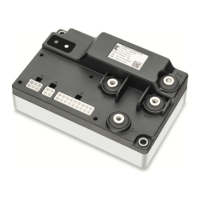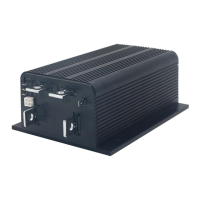3 - APPLICATION-SPECIFIC FEATURES Page: 26 THROTTLE Discusses throttle usage, types, and fault protection for acceleration or braking control.
Throttle Type 1 Describes 2-wire 5kΩ–0 potentiometers and their wiring and parameter settings.
Throttle Type 3 Describes 2-wire 0–5kΩ potentiometers and their wiring and parameter settings.
Throttle Type 5 Explains using VCL for throttle signal input, offering flexibility and customization.
MOTOR SPEED CONSTRAINTS Details the three constraints that define the maximum motor speed allowed by the controller.
VOLTAGE LIMITS Explains overvoltage and undervoltage protection thresholds for high and low power circuits.
ISOLATION MONITOR Explains the internal circuit that measures insulation resistance between high power and chassis.
4 - PROGRAMMABLE PARAMETERS Page: 33 PROGRAMMING MENUS Parameters are grouped into nested hierarchical menus for customization.
2 - TORQUE MODE MENU Parameters for torque control mode, including speed limiter and response settings.
THROTTLE MENU Parameters for configuring throttle input types, deadbands, mapping, and filtering.
BRAKE MENU Parameters for configuring brake input types, deadbands, mapping, and filtering.
EM BRAKE CONTROL MENU Parameters for controlling the electromagnetic brake function, including type, voltage, and timing.
DRIVERS MENU Parameters for configuring individual driver outputs, including main contactor and driver 3.
MOTOR MENU Parameters related to motor characteristics, including max speed and technology type.
BATTERY MENU Parameters for battery voltage settings, BDI, and insulation resistance monitoring.
VEHICLE MENU Parameters for vehicle settings like units, speed-to-RPM conversion, and capture data.
CAN INTERFACE MENU Parameters for configuring CANopen communication, node IDs, and message rates.
5 - MONITOR MENU Page: 80 INPUTS MENU Displays real-time values for all controller inputs, including throttle and switches.
OUTPUTS MENU Displays real-time values for all controller outputs, including PWM and digital outputs.
VEHICLE MENU Displays real-time vehicle data such as speed, odometer, and distance traveled.
BATTERY MENU Displays battery status information like BDI, capacitor voltage, and insulation resistance.
MOTOR MENU Displays motor status information such as RPM, temperature, and encoder feedback.
CONTROLLER MENU Displays controller status, including current, state, errors, and VCL status.
MOTOR TUNING Displays motor tuning parameters like Base Speed Captured and Test Field Current.
7 - INITIAL SETUP Page: 91 Step 3: Battery Instructions for setting the nominal battery pack voltage and considering Li-ion battery recommendations.
Step 5: EM Brake Instructions to set up parameters in the EM Brake Control Menu if applicable.
Step 6: Throttle Guides verifying interlock and setting up throttle type, deadbands, and mapping.
Step 7: Brake Guides verifying interlock and configuring brake parameters like type, deadbands, and mapping.







